Superior craftsmanship is marriage of skill, proper tools, and quality materials. Well-made cocktails are no exception. Although the caliber of your ingredients may be the most important factor in a fine drink, bar equipment is essential for giving the drink the proper temperature, proportion, consistency, and appearance. Beyond substance, cocktail tools also impart essential style to the mixing experience. A cocktail, after all, is more than simply a beverage. It is also a performance, a gift uniquely created for an individual. By making drinks for your guests, you are practicing one of the highest forms of hospitality and it’s even more fun if you put on cocktail attire.
Acquiring and understanding your tools & bar equipment will give you the confidence to make excellent mixed drinks. In this article, I briefly sketch the history of bar tools, and then outline the implements you will want to have on hand as you practice crafting cocktails at home.
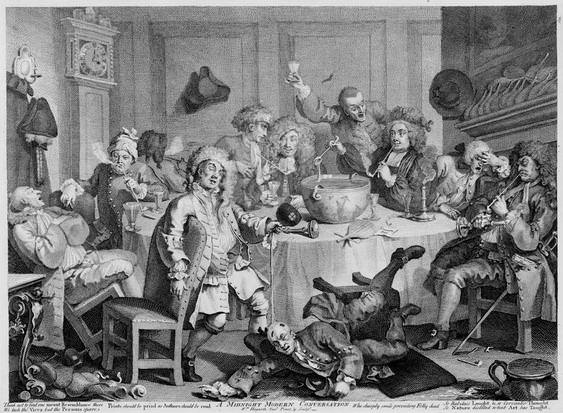
A Brief History of the Tools used for Mixing Drinks
The human relationship with alcohol extends far into the past, and, for much of that time, it appears as if mixing was an important part of the drinking process. One famous example from the classical world is the Greek practice of mixing wine with water, in a large earthenware pot called a krater. The greatest drinking party in western philosophy, Plato’s Symposium, involves Socrates and his companions discoursing on love over bowls of mixed wine. (A symposium in ancient Greece was an occasion for drinking and conversation.)
Jumping ahead a few millennia to the 18th- and early 19thcenturies, mixed drinks commonly took the form of hot toddies and punches, many based in brandies and rums. The punch bowl of the 18thcentury has some parallels, culturally speaking, with today’s cocktail shaker, although they obviously served different functions. Another notable bar tool from this era was the “toddy-stick.” Cocktail historian David Wondrich in Imbibe!, an excellent account of drinking culture in America, explains that the toddy-stick was a precursor to the modern muddler, used to crush sugar and stir it into a drink.
Wondrich also makes the interesting observation that the increased availability of ice in the mid-nineteenth century was a catalyst in American drinking culture, popularizing cold drinks and, eventually, giving birth to the cocktail as we know it today. The term “cocktail” itself of uncertain coinage, although it appears to be American in origin. Salvatore Calabrese in Classic Cocktails reports that the cocktail was defined as an alcoholic drink as early as 1806. Calabrese also relates a number of lively anecdotes that have been attributed to the coining of the term, ranging from stolen fighting cocks to a mispronunciation of a young girl’s name. I highly recommend his summary of these stories, although many of them can also be found on various websites.
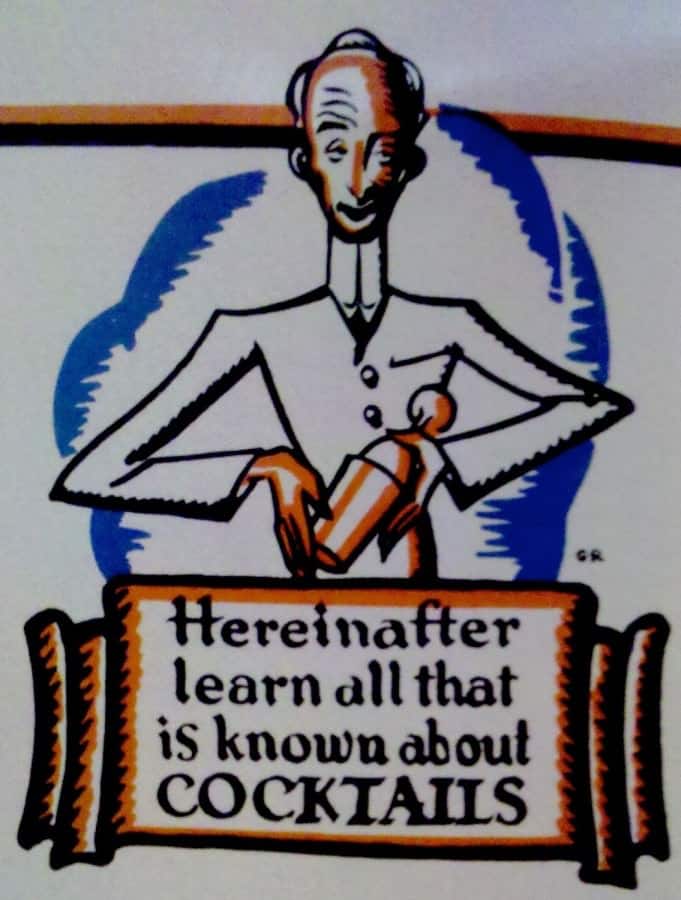
As cold drinks increased in popularity during the mid-nineteenth century, the tools for serving these drinks were largely developed ad hoc by various bartenders. One of the more famous bartenders was Jerry Thomas, who presided over various bars around the United States. In 1862, Thomas authored How To Mix Drinks, or The Bon-Vivant’s Companion, one of the first cocktail guides. As Wondrich reports, early bartenders would actually mix drinks by “tossing” the ice, spirit, and other ingredients back and forth between two glasses. In the image below, you can see Jerry Thomas mixing his signature Blue Blazer cocktail in this fashion, although in this particular case the whiskey was alight during the tossing process. While undoubtedly flashy if done properly, this method was certainly liable to regular messes and mishaps (potentially serious, if flaming alcohol was involved!). Bartenders soon began using a metal cup that fit over a mixing glass, thus containing and simplifying the shaking process. This device would eventually evolve into the contemporary Boston shaker. Other standard bar tools, like the julep strainer and the long, twist-handled bar spoon, also originated during this time.
Although the twentieth century would bring many changes to the concoction and production of drinks, it is worth noting that most of the classic tools and mixing techniques had already been established by the time of Prohibition. With this basic history of some key bar tools in mind, we can turn to some of the essential tools that every home bartender should own.
Acquiring & Using Essential Bar Equipment
The following discussion offers a description of basic mixing tools and their use. Given that the focus of this article is mixed drinks, I am not going to discuss accessories for wine and beer consumption (such as corkscrews, bottle openers, champagne coolers, etc.). Additionally, depending upon your set up, you may find other accessories to be essential. For instance, if you decide to stock a sideboard or bar away from the kitchen, you will likely need an ice bucket and tongs. Many of these tools are widely available through Amazon and other websites, and in a variety of styles; I give specific recommendations to get you started.
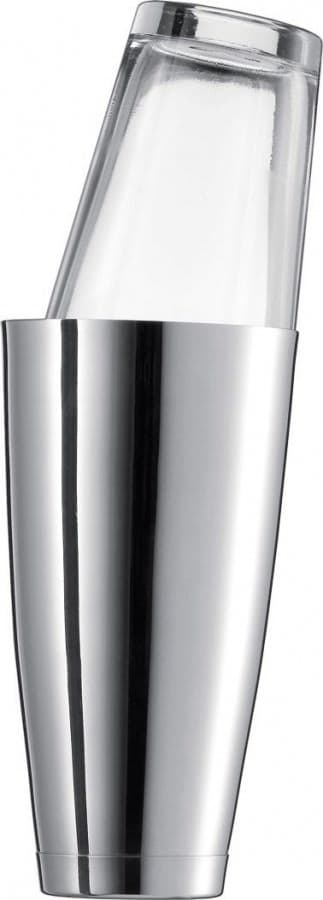
Shakers
The two most common cocktail shakers on the market today are the two-piece Boston shaker and the three-piece Cobbler shaker. The origin of the term “Boston Shaker” is apparently unknown; Wondrich traces the “Cobbler shaker” to Britain, where it was named after the “cobbler” mixed drink.
Boston Shaker
The Boston shaker consists of a mixing glass (often a pint glass), over which is fitted a large metal mixing lid. A seal is created between the mixing glass and lid, and the whole apparatus is then shaken firmly. The mixing glass can also be used alone for stirring drinks that are not to be shaken. Typically, the cocktail is then strained into a glass using either a Hawthorne or, less commonly, a julep strainer (discussed below). The cobbler shaker can come in many sizes, although it is often smaller than the Boston shaker. The metal base is sealed with a two-part lid, consisting of a built-in strainer and a cap.
Functionally, a shaker’s primary use is for the mixing and chilling of drinks, but this is only one of its many important roles. You can also use your shaker for muddling ingredients or crushing ice, as is called for in some mint julep recipes.
We like this Boston shaker from WMF. Alternatively the Birdy is great too and so are the shakers from Yukiwa, specifically the 500ml shaker. Which is great for a Ginza hard shake as invented by Kazuo Uyeda from the Tender Bar in Ginza, Tokyo, Japan. You can watch Mr. Uyeda artfully shaking a drink below.
Some may tell you the Boston shaker is difficult to use when you start our but the video below explains in details how to use a Boston shaker correctly.

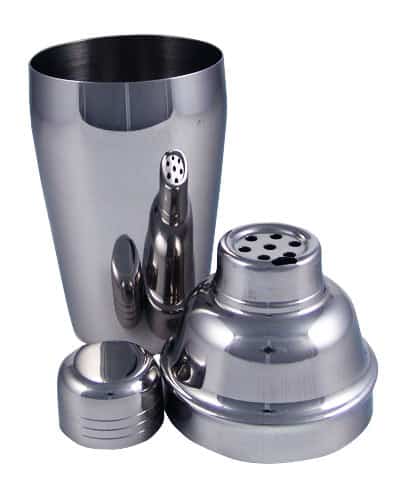
Cobbler Shaker
Your choice of shaker is largely a matter of preference. Because of its more compact size and ease of use, I consider the cobbler to be adequate for most home uses. Additionally, its elegant shape is often a stylish addition to a bar or sideboard. The Boston is larger, requires a little more technique, but it is also more versatile and probably more commonly used by most professionals.
Both forms of shaker are widely available, in a variety of price ranges and styles. If you are looking for something unique, Kaufmann Mercantile retails a particularly striking pewter Cobbler shaker .
For those who opt for a Boston shaker, here is a helpful video from Imbibe magazine on its proper use. Note, too, that this bartender measures out his drinks, a subject to which I now turn.
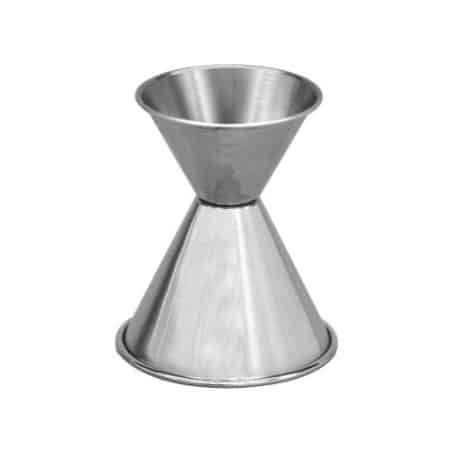
Jigger
Used for measuring, a jigger is shaped like a reversible shot glass, with typically one measure twice as large as the other (for instance, 2 oz/1 oz). I consider the jigger to be second only to the shaker in order of importance. The right proportions can turn a drink into a revelation; wrong proportions, a disaster. Some bartenders are able to count off the ounces as they mix drinks, but I wouldn’t recommend it (and many professionals insist on measuring). Measuring out your drinks is the first piece of advice I would offer for crafting superior cocktails. I will save other tips and tricks for a later column.
There are literally endless jigger options out there, the most popular being the two sided cone-shaped jiggers. The problem with standard jiggers is that you only get two measurements and so you need a whole collection to get all the proper combinations. This is where the OXO jigger cup, the OXO jigger, or Uber Pro Jig come into play. They all provide measurements for various different sizes, and while my favorite is probably the jigger cup all perform well.
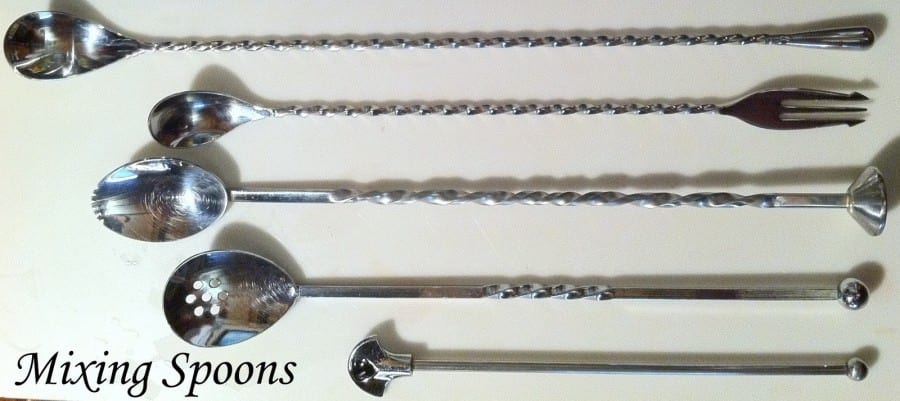
Bar Spoon
The long, twisted handle of the traditional bar spoon originates in the nineteenth century. The length allows you to stir drinks effectively within a large mixing glass or shaker. One account for the twisted handle is that it makes it easier to spin the spoon, which is sometimes used as a stirring technique.
While on the subject of spoons, I should offer a few thoughts on shaking versus stirring. As one would expect, shaking is a more robust form of mixing, typically used with drinks that use fruit juices and other viscous ingredients (as in the Gimlet made in the above video). Shaking will leave the drink slightly cloudy, and possibly with miniscule ice chips, both of which can be desired effects. Shaking is also important when making a drink that uses egg whites, as in many traditional sours, giving the egg a smooth, frothy texture. Stirring, on the other hand, cools and mixes the drink more gently, retaining the spirit’s clarity and some say smoothness, which is why many authors insist that a drink like a Manhattan or Martini always be stirred. I think the argument for clarity makes the most sense, although you will occasionally hear the dubious claim that shaking can “bruise” the spirit.
Most recipes will tell you whether to shake or stir, and it is always best to heed the instructions.
The basic model has that little red plastic knob on the end and a spiral shaft and costs less than $5. A nicer collection of bar spoons is offered by Cocktail Kingdom.
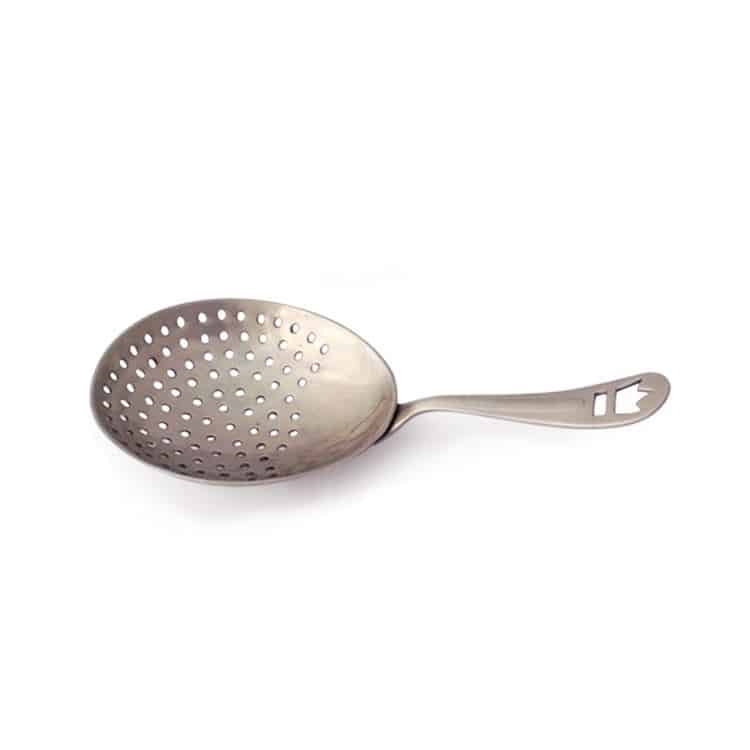
Strainer
The Hawthorne strainer (named after the Hawthorne Café in Boston) is probably the most common, easily recognized by the springs that rest within the mixing glass. A julep strainer does not have springs, and is slightly bowl shaped. According to the Mr. Boston cocktail guide, the Hawthorne strainer is to be used with the metal part of a Boston shaker, while the julep is to be used with a mixing glass. I am unfamiliar with this rule, and find most bartenders using the Hawthorne whenever a strainer is required. A basic Hawthorne strainer can be found here.
The obvious function of a strainer is to separate the drink from the ice whenever this is required. In some drinks a fine mesh strainer is also used to remove fruit pieces or other ingredients from the finished cocktail.
Even if you opt for a cobbler shaker, I find that a hand-held strainer is often more precise than the one built into the cobbler lid. If purchasing separately from your shaker, make sure that the strainer correctly fits.
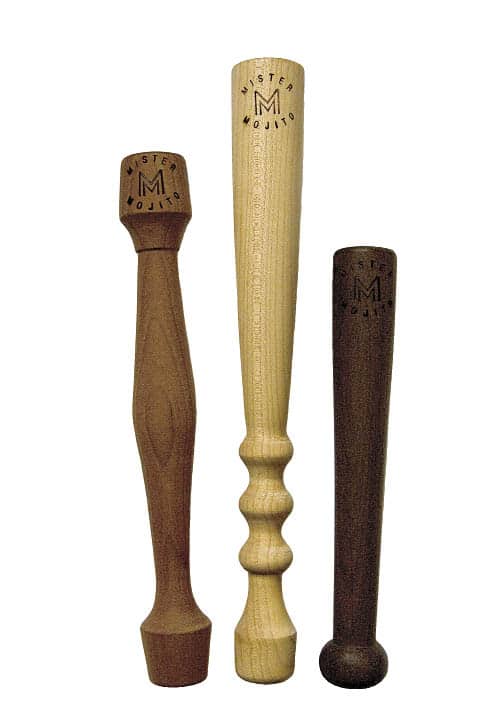
Muddler
A muddler is used for crushing fruit, fruit peels, and herbs, extracting the essential oils and juices and, in some cases, mixing ingredients together. An old fashioned, for instance, requires muddling sugar, fruit, and bitters, while a mint julep calls for muddling mint leaves and sugar. Additionally, it can be used for crushing ice, should a recipe require it.
While you can find plastic and steel muddlers, I prefer wood, both for ease of use and durability. I’ve been particularly pleased with this all maple muddler crafted in the USA. The muddlers in the image come from Mr. Mojito , and appear to be well-made, although I’ve not used them myself.
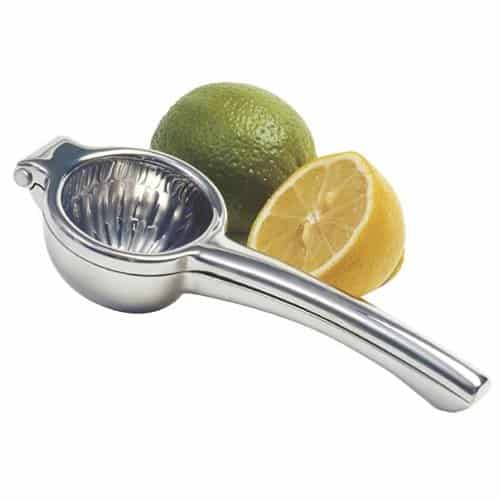
Juice Press
Fresh fruit juice vastly improves the quality of your drinks. Therefore, a juice press is an important tool to keep in your bar. I recommend the mechanical, hand squeezed device. It is easy to use and clean, as well as reliable. If you plan on making large quantities of cocktails, you may consider a countertop commercial press, although something of this size is probably unnecessary for home cocktail needs.
Knives, Peelers, and Zesters
A small paring knife is useful for cutting fruit and making some garnishes. I personally keep both a regular peeler (not a Y-peeler but some prefer it) and a zester on hand. I use the former for the thicker twists that I put in an old fashioned; the latter is useful for making the long, thin twists that compliment many cocktails served up (that is, without ice).
When making twists, be sure you peel the fruit while holding it over the top of the finished cocktail, as this will release additional oils, adding to the aroma and experience of the drink.
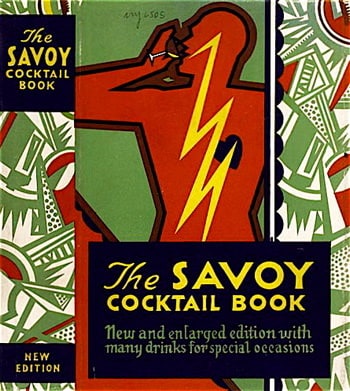
Cocktail Guides
While there are many excellent resources on the internet, I find that a print guide to mixing drinks is an essential addition to any home bar. Many of the books referenced throughout this article offer excellent surveys of the world of spirits; in addition to such texts, I also enjoy having two recipe books, one vintage and one contemporary.
All of the books I have mentioned in this article come highly recommended, particularly if you are interested in learning more about the history of cocktails, recipes, and distillation. Additionally, I find that reading both classic and contemporary guides to bartending can offer a rich, historically nuanced education in the craft.
Jerry Thomas’s How To Mix Drinks, or The Bon-Vivant’s Companion can still be found on the web or in facsimile, and having the first cocktail manual on hand shows that you know your history. Moving forward some 70 years, the Savoy Cocktail Book by Harry Craddock is a standard from the Prohibition Era. Craddock tended bar at the Savoy Hotel in London, which was frequented by many American tourists seeking legal libations. The illustrations are particularly attractive, and reprints are widely available. For a mid-century vintage cocktail book, Esquire magazine’s Handbook for Hosts, first published in 1949, can still be found in used editions, offering tips for drinks, parties, and dining at home. The list of beverages is not as extensive as that found in the Savoy, but it is also a pleasurable, sassy read.
Among contemporary cocktail guides, the Mr. Boston Bartender’s Guide has gone through several additions since it was first published in 1935. The Platinum Edition in particular contains over 1,500 recipes, with useful tips and illustrations. Simon Difford’s Encyclopedia of Cocktails also comes highly recommended, although I have not looked at a copy myself. The book is particularly useful for outlining the essential ingredients that would allow one to make most of basic cocktails.
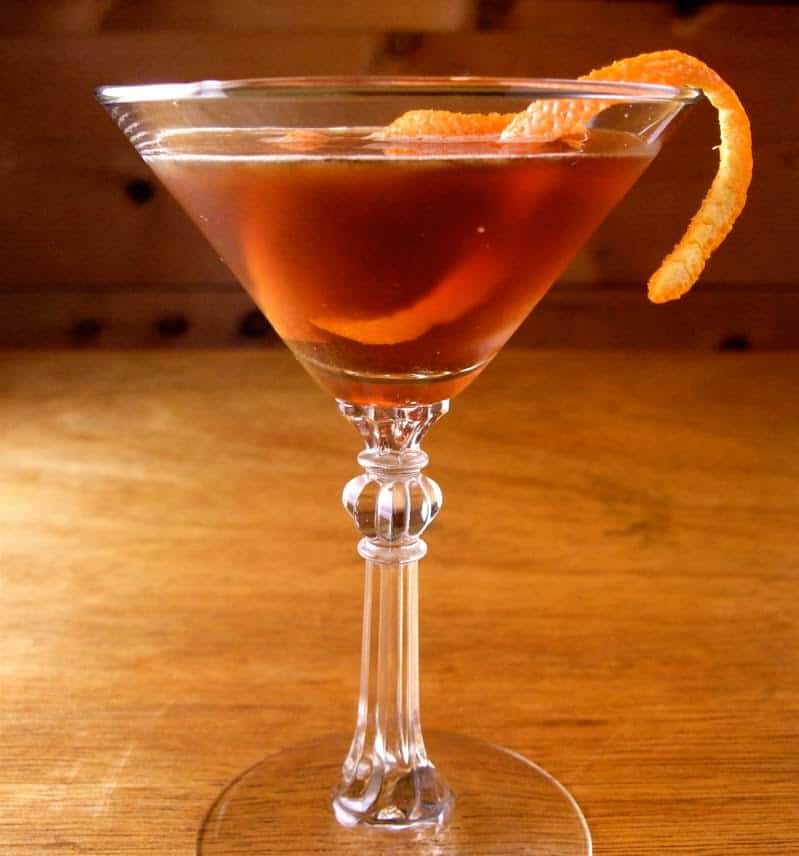
Cocktail glasses & Serving Accessories
The history and use of glassware deserves an article of its own, so I will keep this discussion to the basics. I believe that three kinds of glasses will cover the vast majority of classic drinks:
- the cocktail glass (also called the “martini glass”)
- the old fashioned glass and
- the highball or Collins glass
I would recommend that you begin by purchasing 4 to 6 of each, adding to your collection as necessary (or if you decide to host a larger group of guests).
Cocktail Glasses
The cocktail glass is familiar to everyone, consisting of a base, stem, and cone-shaped bowl. These glasses are designed for most drinks served “up,” or without ice, although there are a few instances of drinks served up in an old fashioned glass (such as the sazerac). Jason Wilson, spirits columnist for the Washington Post and author of the fascinating Boozehound , notes that most contemporary cocktail glasses are too large, sometimes twice as big as the traditional 4.5 ounce size. A cocktail is meant to be enjoyed while it is appropriately cool. Too large of a drink in an oversized glass will be warm before it is finished. Additionally, it is easy to over-consume when making large drinks.
Unfortunately, properly sized cocktail glasses can be hard to find. Nora Maynard suggests looking for vintage glassware on places like Ebay, which can certainly give your drinks a classic flair. A little searching on Amazon can turn up a wide variety of cocktail glasses in a range of styles, sizes, and prices. The choice is ultimately up to you, but I do recommend something on the smaller end.
Old Fashion Glasses
Old fashioned glasses, named after the classic whiskey drink, are heavier and shorter, holding between 6-8 ounces. These can be found in a variety of designs and shapes. I prefer a thick bottomed, heavier glass, such as this set by Schott Zwiesel. You can also use these glasses to serve spirits neat.
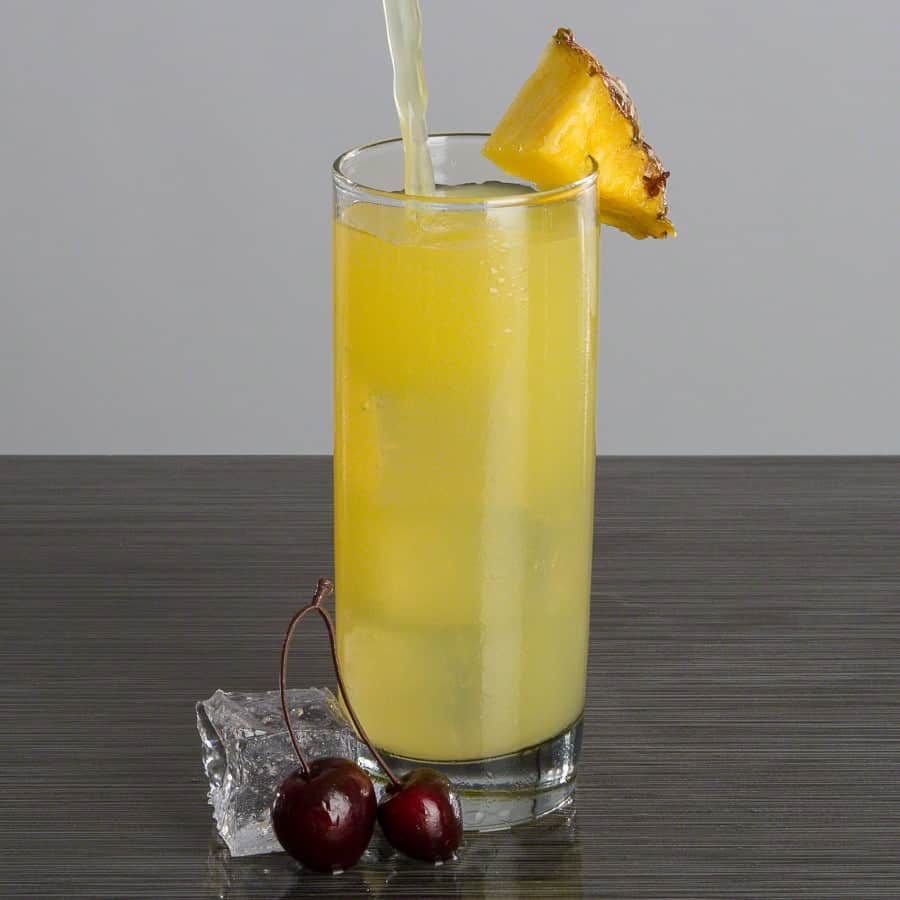
Collins Glasses
Collins glasses, named for the Tom Collins cocktail, can be used to serve most mixed drinks on the rocks. It is a tall thin glass, holding 8-12 ounces. Highball glasses, which are slightly thicker and shorter than a Collins, are used to serve highballs, a term often used to describe drinks “this & that” drinks such as a gin & tonic or whiskey mule. Basically, all of them have a higher proportion of a mixer to alcohol. Either a Collins or highball glass will work in most situations that call for drinks on the rocks, and so picking one over the other (or both) is a matter of taste. I find this set of Collins glasses by Schott Zwiesel both elegant and affordable. You can also purchase the same glass in a highball size.
Other Glassware
The list of glassware that may be used for mixed drinks can be quite extensive, including champagne flutes, shot glasses, snifters, and cordial glasses, not to mention the various beer and wine glassware that one needs to enjoy these beverages. I recommend that you acquire these glasses as you find them necessary and in proportion to your developing tastes and interests.
Conclusion
Making drinks is a blend of knowledge, art, and craftsmanship. Like any skill, your abilities will improve, given time and practice. With the right tools and resources, however, you will find the learning experience more enjoyable and productive. In future articles, I hope to outline more tips for mixing and serving, as well as highlight the histories and recipes of essential cocktails. In the meantime, become comfortable with the basic tools described here, practicing with one or two favorite drinks. Eventually, you may find that crafting cocktails can be as pleasurable as drinking them. Or almost as pleasurable.
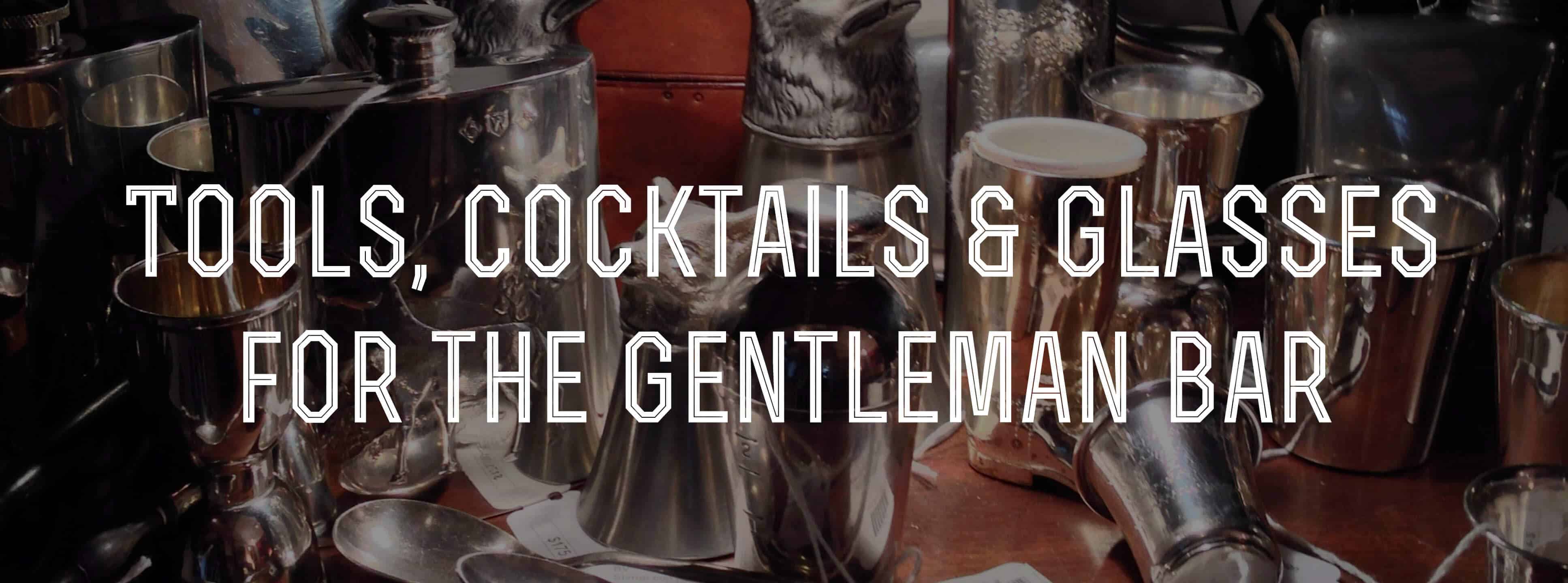

Gentlemen,
This is a wonderful article(s) and I have taken the liberty of posting the link on my blog. I would like to thank you for the huge amount of research you’ve put into it and sharing this knowledge with the rest of the world.
Richard de Meath (Rev)
Thanks for sharing the guide Richard, it is much appreciated.
I ‘ll have a Vodka martini,shake not stir.Could not forget that request , from 007 Mr. Bond(James)
murtadza
Haha – excellent! What shaker do you prefer ;) ?